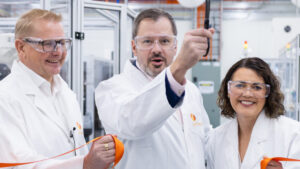These three ASX-listed small caps are plugging into global demand for better batteries

Three ASX-listed small caps plugging into battery demand. Image Getty
Lithium-ion batteries’ cathodes require heavy metals including nickel, cobalt and manganese. These ASX players are finding a better way.
Turbocharged demand for batteries required for clean energy has sparked questions from the International Energy Agency on whether the world even has enough metals and minerals to support the global electrification ambition.
Global battery production is now around 340 GWh/year and it needs to be roughly 10 times higher by just 2030 to produce the amount of batteries required to meet demand, the IEA said at the launch of its Global Electric Vehicle Outlook 2022.
The supply of lithium, for example, will need to increase by up to one-third by 2030 to match demand for EV batteries to satisfy global pledges.
Meanwhile a global nickel shortage is stalling EV producers’ efforts to improve their offerings due to the mineral’s key role in lithium-ion batteries.
But this looming supply crunch scenario is driving exciting innovation and research among some Australian mining and tech companies.
Forging Australia’s supply chain links
Working to plug this crucial demand gap is Poseidon Nickel (ASX:POS). The miner, with Pure Battery Technologies, secured a $119.6 million Modern Manufacturing Initiatives Grant from the Federal Government in March for its proposed development of a battery material refinery hub in Kalgoorlie.
That grant followed the release of modelling from the Future Battery Industries Cooperative Research Centre (FBICRC) showing a diversified battery industry could contribute more than $7 billion to the Australian economy annually and sustain 34,000 full-time jobs by 2030. That’s up from a $1.3 billion addition to GDP and 6,000 jobs in 2021.
Another company embodying the evolution urged by the FBICRC is PPK Group (ASX:PPK).
PPK switched its focus from mining to developing joint ventures with universities to incubate and commercialise promising technology.
The first of these JVs to be spun out through an IPO last September is Li-S Energy (ASX:LIS).
Li-S has been playing a leading role in lithium sulphur (LiS) battery research and collaborating with scientists at Deakin University’s ManuFutures 3 facility.
The work being done at this advanced manufacturing innovation hub within Deakin’s Future Economy Precinct will help enable Li-S to target the massive growth in batteries for EVs as well as electric aviation, drones, the Internet of Things and other consumer electronics.
Why lithium sulphur?
Lithium-ion batteries’ cathodes require heavy metals including nickel, cobalt and manganese.
These are expensive, representing up to 34% of the total battery cost, and can have volatile market pricing as we have witnessed this year with nickel.
Sulphur, on the other hand, is abundant in the Earth’s crust and is often created as a discarded by-product of other industrial processes.
The lower mass of lithium metal needed for a lithium-sulphur battery anode also reduces weight and has potential to lower production costs.
For example, lithium-ion batteries currently get up to around 200-250 Watt hours per kilogram, compared to lithium-sulphur batteries with 400-450-Watt hours per kilogram.
Other benefits include the fact that discarded lithium sulphur batteries do not leach heavy metals into the environment.
They’re also recognised by leading scientists as offering potentially the highest energy storage of any battery chemistry, with a theoretical gravimetric energy density of up to five times that of lithium-ion batteries, while posing less risk of ‘thermal runaway’ which can cause fires.
Why not lithium sulphur?
Despite these recognised benefits lithium-sulphur batteries have not yet been mass produced because they have tended to fail after a low number of recharge cycles, making them unviable for most commercial applications.
But Li-S Energy’s R&D has demonstrated that integrating Boron Nitride Nanotubes (BNNTs) into lithium-sulphur batteries can create a battery cell with a cycle life approaching that of everyday consumer grade lithium-ion batteries.
This breakthrough finally gives lithium-sulphur batteries the potential to be commercialised.
What the acronym are BNNTs?
BNNT is an advanced nano-material, which means it has at least one external dimension that measures < 100 nanometers (nm). This equates to 100 millionths of a millimetre or 100 billionths of a metre or less.
The microscopic material has some unique properties that have even led to it being identified by NASA as a key substance that may help humans reach Mars.
This is because BNNTs are:
- 100 times stronger than steel and 50 times stronger than industrial carbon fibre.
- Able to withstand temperatures of more than 1,000C without degrading.
- 5 times more thermal-conductive than copper while increasing thermal conductivity of other materials.
- As light as carbon fibre, can be bent more than 90 degrees thousands of times without failure and can even self-repair.
In the past BNNTs have been difficult to manufacture cost effectively, and in high purities and volumes.
However those barriers are now coming down thanks to the Li-S Energy partner BNNT Technology Limited’s (BNNTTL) nanotechnology research team finding a way to create the BNNT at only 1,350C compared to the previously required 3,000C.
Using this high-purity low-cost BNNT, Li-S Energy researchers discovered a way to vastly improve the performance of lithium sulphur batteries by introducing interlayers of BNNT, a solution the team has now patented.
Powering up for production
BNNTTL successfully commissioned a $3m-plus BNNT production facility at Deakin’s ManuFutures facility in Geelong in 2020 to further develop Deakin University’s patented manufacturing.
Since then Li-S Energy has signed an exclusive supply and distribution agreement with BNNTTL for the use of BNNTs in battery technology, including exclusive distribution rights to sell BNNTs to manufacturers for use in lithium-sulphur batteries.
Li-S Energy already has a collaboration with Boeing subsidiary Insitu Pacific to integrate and test its battery technology in a range of drones as well as a partnership with Janus Electric to power around 400 electric trucks.
CEO of Li-S Energy Dr Lee Finniear sums up the company’s progress so far: “We have achieved a significant innovation breakthrough with our Li-S battery technology at a time when the world is demanding better batteries and more efficient energy storage devices.
“The commercialisation journey for Li-S Energy Limited has begun and is on track to showcase this Australian company as a recognised leader in this exciting industry.”
To enable its growth Li-S Energy is expanding its production capabilities with a new state of the art facility at Deakin’s ManuFutures 3 facility, which will give the company continued access to world-class R&D capabilities as it scales.
This article was developed in collaboration with Poseidon Nickel, PPK Group and Li-S Energy, all Stockhead advertisers at the time of publishing.
This article does not constitute financial product advice. You should consider obtaining independent advice before making any financial decisions.
Related Topics

SUBSCRIBE
Get the latest breaking news and stocks straight to your inbox.
It's free. Unsubscribe whenever you want.
By proceeding, you confirm you understand that we handle personal information in accordance with our Privacy Policy.








